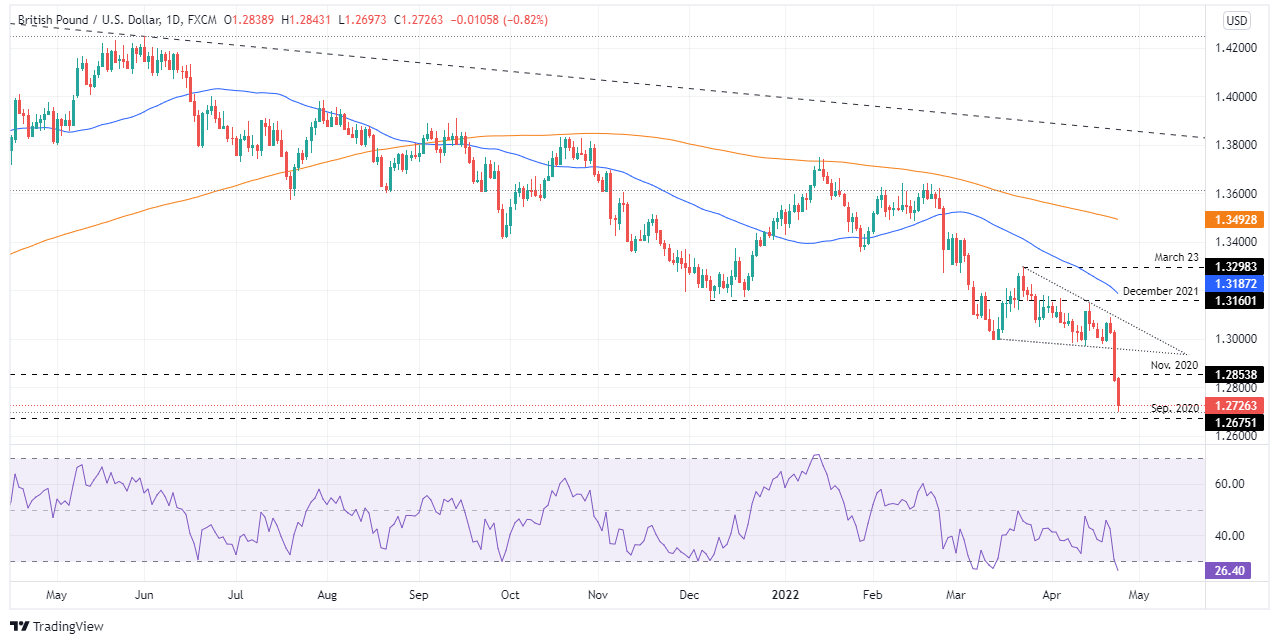- Analytics
- News and Tools
- Market News
- GBP/USD reclaims 1.2700 after plunging towards multi-year-lows around 1.2690s
GBP/USD reclaims 1.2700 after plunging towards multi-year-lows around 1.2690s
- The British pound extended its last week’s losses on weaker than expected UK economic data.
- Also, a dismal market mood and flight to safe-haven assets weighed on the GBP boosts the USD.
- GBP/USD Price Forecast: To remain downward pressured unless the 1.3000 is reclaimed.
The GBP/USD plummets to fresh multi-year lows, below the 1.2700 mark, amidst a dampened market mood and odds that the US central bank would hike rates aggressively throughout the year. In the FX space, the greenback remains in the driver’s seat, while risk-sensitive currencies like the GBP, the CAD, and the antipodeans fall. At the time of writing, the GBP/USD is trading at 1.2726 in the North American session.
Sentiment turned sour on China’s Covid-19 outbreak, central bank tightening
Global equities still cling to losses. China’s Covid-19 outbreak over the last two weeks in Shanghai threatens to extend to Beijing, as reported by Reuters. Also, Fed expectations of a 0.50 bps increase in the US, on a slowing economic outlook, threaten to trigger a global “stagflation,” as mentioned by some financial analysts.
The GBP/USD recorded losses of 1.71% in the last week on weaker than expected UK economic data. A worse than expected April’s Gfk Consumer Sentiment (at -38 vs. -33 foreseen) kept the British pound under pressure, hitting its lowest level since the Global Financial Crisis (GFC) of 2008. It is worth noting that a GfK Consumer Sentiment reading has preceded four of the last five recessions in the UK. Additionally, the drop in the Retail Sales from -0.3% estimated to -1.4% emphasizes that the UK economy is losing momentum, painting a cloudly environment as the Bank of England (BoE) goes through its tightening cycle.
Elsewhere, last week comments from Bank of England (BoE) Catherine Mann prepared the case for a 50-bps rate hike in May. Nevertheless, with weaker than expected data in the previous week, analysts at Rabo bank wrote in a note that “on the heels of the retail sales plunge in March, it may be tough to convince the majority of the MPC to announce a move larger than 25 bps next month. In the face of strong inflationary pressures, it is our view that the Bank will announce three more 25 bps rate hikes in the coming months bringing the peak in rates to 1.5%.”
GBP/USD Price Forecast: Technical outlook
The GBP/USD remains downward pressured but fell short of testing September’s 2020 cycle lows around 1.2675, staging a recovery towards current price levels. The bounce off 1.2697 YTD lows provided some air to GBP/USD bears because the Relative Strength Index (RSI) reached oversold conditions, with its reading at 26.40. Nevertheless, once the RSI reclaims 30, further downside is expected.
With that said, the GBP/USD first support would be the YTD low at 1.2697. Once cleared, the next support would be September’s 2020 cycle lows around 1.2675, followed by July’s 2020 swing lows near 1.2479.

© 2000-2024. All rights reserved.
This site is managed by Teletrade D.J. LLC 2351 LLC 2022 (Euro House, Richmond Hill Road, Kingstown, VC0100, St. Vincent and the Grenadines).
The information on this website is for informational purposes only and does not constitute any investment advice.
The company does not serve or provide services to customers who are residents of the US, Canada, Iran, The Democratic People's Republic of Korea, Yemen and FATF blacklisted countries.
Making transactions on financial markets with marginal financial instruments opens up wide possibilities and allows investors who are willing to take risks to earn high profits, carrying a potentially high risk of losses at the same time. Therefore you should responsibly approach the issue of choosing the appropriate investment strategy, taking the available resources into account, before starting trading.
Use of the information: full or partial use of materials from this website must always be referenced to TeleTrade as the source of information. Use of the materials on the Internet must be accompanied by a hyperlink to teletrade.org. Automatic import of materials and information from this website is prohibited.
Please contact our PR department if you have any questions or need assistance at pr@teletrade.global.















